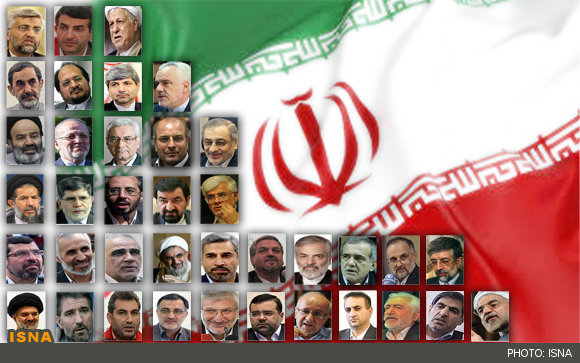Iran Analysis: Presidential Election --- Good-bye Parties; Hello, Personalities and "Atomised Politics"

Registered candidates in the 2013 Presidential election
In an attempt to get some grip on the fast-moving and complex developments in Iran's Presidential race, Western media have been putting out the narrative that two "wild cards" --- former President Hashemi Rafsanjani and President Ahmadinejad's right-hand man Esfandiar Rahim-Mashai --- have shaken up the election process.
This narrative is a small part of the wider story, even if the way it has presented Rahim-Mashai is exaggerated. In his case, the significance is not that --- if allowed to run --- he will win, but that his candidacy will complicate the first-round election, drawing attention and votes from the leading contenders.
However, while it makes for catchy headlines, this Western media narrative is at best an overly-simplified, easy-to-digest soundbite, a single jigsaw piece in a complex bigger picture.
This bigger --- and far more interesting --- picture is summarised by an Iran-based EA correspondent:
This is the end of factionalism --- conservative v. principlist v. reformist; "Left" v. "Right". It is personalised behaviour and atomised alliances that now distingush the elections.
That analysis buttresses the important revelation this year that the Supreme Leader's camp does not control this process, failing to put forth a "unity" candidate even by this late stage in the game. However, it also raises the possibility that after 34 years, politics is the Islamic Republic is on the verge of a major shift.
The classifications of factions in Iran since 1979 have been of the "conservative" forces that led the country in its first decades, of the "reformist" wave with President Mohammad Khatami from the late 1990s, and the "principlist" re-alignment accompanying the rise of Mahmoud Ahmadinejad in 2005. While there are further dimensions within these classifications --- for example, the role of clerics, business interests, and of the Revolutionary Guards and the military --- these were the guidelines for the Iranian political system.
But in this 2013 campaign, those guidelines have eroded. As only Ayatollah Khamenei's men but also the established factions have failed to put forth a standard-bearer, individuals have taken their chance, forming temporary alliances and advancing their campaigns.
Consider Rafsanjani. Although a leading figure in "conservative" politics since the early days of the Islamic Republic, he had been put outside the main factions after his role --- risking a Tehran Friday Prayer supporting protest --- after the disputed 2009 Presidential election. He had lost his leadership of the Assembly of Experts, had been denigrated and demoted by the media, and had seen his children imprisoned.
Yet, defying those who said he was finished, Rafsanjani has been making alliances outside the factions and using his remaining positions such as chair of the Expediency Council. He has worked with long-term allies like Hassan Rohani, a senior Council official, and has established links with figures like former President Mohammad Khatami.
Rafsanjani watched as others reacted to the party breakdown with their own alliances and moves, for example, the "Coalition of 5" leading principlist politicians who grew impatient with the failure of the Supreme Leader's men to find "unity". He noticed that the established "conservative" forces such as the Motalefe Party did not have a favourite, and that the military, notably the Revolutionary Guards, had not made an endorsement.
Rafsanjani calculated and planned for months and then on Saturday, at the last minute and after manoeuvring with the Supreme Leader's office, he entered the race.
Consider Rahim-Mashai. His campaign will not have a conservative or principlist base. Instead, his influence --- if he has any --- will come from the informal networks around his patron, Mahmoud Ahmadinejad.
Rahim-Mashai and Ahmadinejad are no longer part of the political system, or least a system organised around factions --- they operate outside it.
Or consider the emerging candidate in the crowded field, Saeed Jalili. The Secretary of the National Security Council has never stood for elective office. He has not been a leading member of a political party. While there were rumours since late 2012 of his candidacy, he was not featured in discussions of the Supreme Leader's 2+1 Committee or of other conservative or principlist movements.
Yet Jalili, seeking and to some extent obtaining alliances with other politicians and --- perhaps more importantly --- establishing himself as a candidate for the military --- is already among the front-runners. He may have built up a strong enough position to be courted by the Supreme Leader's camp as their man for the 14 June election.
What does this shift from parties to personalities and atomised politics mean?
The easy notion of a Supreme Leader manipulating and shaping politics through his position and networks is under strain. Ayatollah Khamenei finds that he is not acting but reacting to the initiatives of others.
Of course, the Supreme Leader is far from a neophyte or a bumbler. He and his inner circle will make their own calculations and then take their next steps, trying to re-assert "control".
However, they will have to do so in a new environment, dealing with individuals --- a Jalili or Rafsanjani --- rather than organised parties. And that environment will bring ripples and re-alignments in Iran's domestic and foreign policies long after 14 June.

 Tuesday, May 14, 2013 at 7:32
Tuesday, May 14, 2013 at 7:32
Reader Comments